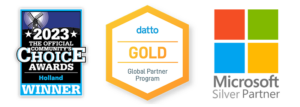ThreatLocker’s Application Allowlisting allows you to deny any application from running on your device that isn’t already in your allowlist.
What is Application Allowlisting?
Application Allowlisting denies all applications from running except those that are explicitly allowed (in your allowlist). This means untrusted software, including ransomware and other malware, will be denied by default.
How Does Application Allowlisting Work?
When Application Allowlisting is first installed, it operates in Learning Mode. During this period all applications and their dependencies that are found or running on the computer are cataloged and policies are created to permit them.
After the learning period, the IT administrator can review the list of applications, remove those that are not required, and secure the computer.
Once the computer is secured, any application, script, or library that tries to execute that is not trusted will be denied. The user can request new software from the IT administrator, and it can be approved in 60 seconds.
Why Use Application Allowlisting?
Application Allowlisting has long been considered the gold standard in protecting businesses from known and unknown malware.
Unlike antivirus or traditional EDR, Application Allowlisting puts you in control of what software, scripts, executables, and libraries can run on your endpoints and servers.
This approach stops not only malicious software but also stops other unpermitted applications from running. This process greatly minimizes cyber threats and other rogue applications running on your network.
Take control of your organization’s security, Contact us today to learn how the ThreatLocker Zero Trust security solution can help your business. As a Holland, Michigan Managed Service Provider (MSP), we offer more than just server disaster recovery and break-fix IT support. We evaluate and organize your network, keeping your data backed up and secure—at all times.

President / Network Architect
Mark Kolean always had a fascination with technology from the time he was 3 and his gift of the Atari 2600 to current. In 1990 at the age of 14 Mark got his first job in customer support for a mail order business supporting Tandy TSR-80 computer software shipped on cassette tape. A few years later Mark was building hundreds of 286, 386, and 486 computers for the new emerging DOS & Windows 3.1 computers that had exploded on the market.
After a college career studying business and technology Mark Started Shoreline Computer Systems in 1999 at the height of the dot.com boom with the looming crisis of the year2k bug just around the corner. In the early 2000’s a lot of work was done with early network systems including Lantastic, Novell, and Windows NT Server. Mark became a community contributor to the Small Business Specialist community that revolved around Small Business Server 2000-2011 which focused on single or dual server environments for businesses up to 50 in size. Networks during this time frame mostly had a break fix relationship in which work was billed only when a problem occurred.
In the 2010’s Microsoft released their first cloud based software called Microsoft BPOS which would in later become known as Microsoft Office 365. This introduced a new model in technology with pay as you go subscription services. Starting in 2013 Mark’s team at Shoreline Computer System rebranded as Shoreline Technology Solutions to focus on the transition to become proactive and less reactive to data backup and security needs. Starting in 2018 all customers are required to have a backup management plan in place as a center point with the full understanding that if STS isn’t watching the customer’s data, then no one is.
Now in Mark’s 22 years of business he is building a company emphasis of how to help customers retire servers and build networks completely in the cloud.


Leave a Reply
You must be logged in to post a comment.